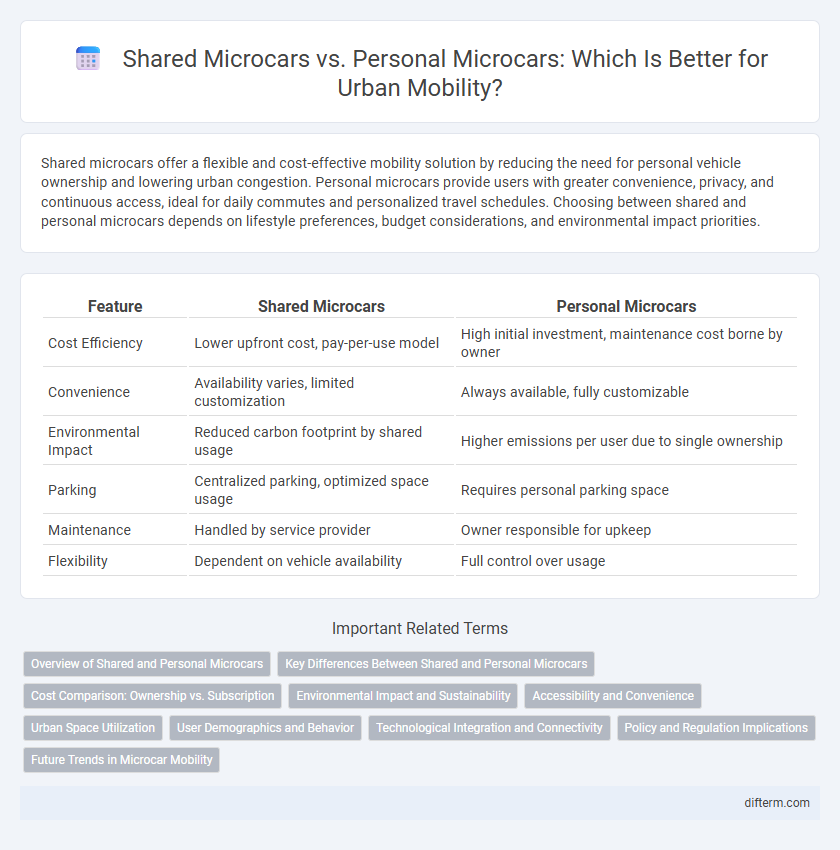Shared microcars offer a flexible and cost-effective mobility solution by reducing the need for personal vehicle ownership and lowering urban congestion. Personal microcars provide users with greater convenience, privacy, and continuous access, ideal for daily commutes and personalized travel schedules. Choosing between shared and personal microcars depends on lifestyle preferences, budget considerations, and environmental impact priorities.
Table of Comparison
| Feature | Shared Microcars | Personal Microcars |
|---|---|---|
| Cost Efficiency | Lower upfront cost, pay-per-use model | High initial investment, maintenance cost borne by owner |
| Convenience | Availability varies, limited customization | Always available, fully customizable |
| Environmental Impact | Reduced carbon footprint by shared usage | Higher emissions per user due to single ownership |
| Parking | Centralized parking, optimized space usage | Requires personal parking space |
| Maintenance | Handled by service provider | Owner responsible for upkeep |
| Flexibility | Dependent on vehicle availability | Full control over usage |
Overview of Shared and Personal Microcars
Shared microcars offer flexible, cost-effective urban mobility solutions by reducing parking demand and emissions through pooled usage, whereas personal microcars provide individual ownership benefits such as complete control and customization. Shared microcars typically operate via app-based platforms enabling short-term rentals, promoting sustainability and decreasing traffic congestion. Personal microcars cater to users seeking consistent availability and personalized convenience, often involving higher upfront costs and maintenance responsibilities.
Key Differences Between Shared and Personal Microcars
Shared microcars offer flexible access without ownership costs, enabling users to rent vehicles on demand through apps, reducing parking and maintenance responsibilities. Personal microcars provide consistent availability and customization, creating a sense of ownership and personal identity but with higher upfront investments and ongoing expenses. Shared microcars promote sustainable urban mobility by optimizing fleet utilization, while personal microcars cater to individuals prioritizing convenience and long-term control over their vehicle.
Cost Comparison: Ownership vs. Subscription
Shared microcars eliminate upfront purchase costs and reduce expenses related to maintenance, insurance, and parking fees, offering a more economical option for short-term or occasional use. Personal microcars require significant initial investment and ongoing costs but provide unrestricted access and customization. Subscription models blend convenience and cost-efficiency, with predictable monthly fees that cover insurance, maintenance, and charging, often resulting in lower total cost of ownership for urban commuters compared to buying a personal microcar.
Environmental Impact and Sustainability
Shared microcars significantly reduce carbon emissions per trip by maximizing vehicle usage and minimizing the total number of cars on the road. Personal microcars, while more sustainable than traditional vehicles due to their smaller size and energy efficiency, often lead to underutilization and increased resource consumption over time. Implementing shared microcar systems supports urban sustainability goals by decreasing traffic congestion, lowering greenhouse gas emissions, and promoting efficient use of renewable energy sources.
Accessibility and Convenience
Shared microcars enhance urban mobility by providing flexible access without the burden of ownership, enabling users to find and reserve vehicles via mobile apps in real time. These shared services reduce parking challenges and maintenance responsibilities, increasing convenience for short trips and spontaneous travel. Personal microcars offer uninterrupted availability and personalized settings, but their ownership requires space for parking and ongoing upkeep, potentially limiting accessibility for city dwellers.
Urban Space Utilization
Shared microcars significantly improve urban space utilization by reducing the number of vehicles parked on city streets, freeing up valuable public space for pedestrians, green areas, and bike lanes. Personal microcars, while compact, still contribute to parking congestion and inefficient space use due to ownership patterns and idle parking times. Data from urban mobility studies show that shared microcar fleets can decrease the overall footprint of personal vehicle storage by up to 40%, enhancing city livability and traffic flow.
User Demographics and Behavior
Shared microcars attract urban millennials and Gen Z users who prioritize cost-efficiency and environmental sustainability, often opting for flexible, on-demand mobility solutions. Personal microcar owners tend to be suburban professionals or small business operators valuing vehicle personalization, privacy, and consistent availability. Usage patterns show shared microcar users favor short, spontaneous trips with high turnover, whereas personal microcar users engage in routine, longer commutes with predictable schedules.
Technological Integration and Connectivity
Shared microcars leverage advanced IoT sensors and real-time data analytics to optimize fleet management and reduce downtime, outperforming personal microcars in connectivity features. Integration with smart city infrastructure enables shared microcars to communicate with traffic systems and parking solutions, enhancing urban mobility efficiency. Personal microcars often lack seamless updates and networked capabilities, limiting their potential for dynamic route planning and remote diagnostics.
Policy and Regulation Implications
Shared microcars demand comprehensive regulatory frameworks addressing vehicle insurance, parking, and urban traffic management to ensure safety and accessibility. Policy implications include incentivizing shared mobility models through subsidies or tax benefits while imposing stricter emissions and usage standards on personal microcars to reduce urban congestion. Regulatory bodies must balance promoting innovative shared transport solutions with safeguarding public interests and infrastructure sustainability.
Future Trends in Microcar Mobility
Shared microcars are projected to dominate urban mobility by 2030 due to rising environmental awareness, cost-efficiency, and reduced parking demand. Advances in electric vehicle technology and smart city integration enhance the appeal of shared microcar fleets over personal ownership. Data from urban mobility studies indicate a 40% increase in shared microcar usage in metropolitan areas, reflecting a shift towards sustainable, flexible transportation solutions.
shared microcars vs personal microcars Infographic

 difterm.com
difterm.com